Textile Composites Market Research, 2032
The global textile composites market was valued at $7.4 billion in 2022, and is projected to reach $14.2 billion by 2032, growing at a CAGR of 6.9% from 2023 to 2032.
Report Key Highlighters:
The report provides competitive dynamics by evaluating business segments, product portfolios, target market revenue, geographical presence and key strategic developments by prominent manufacturers.
The global textile composites market is fragmented in nature among prominent companies such as Chomarat, SAERTEX Group, BGF Industries, Sigmatex, TORAY INDUSTRIES, INC., HYOSUNG TNC, TEIJIN LIMITED, Owens Corning, Hexcel Corporation, and Composite Fabrics of America.
The study contains qualitative information such as the market dynamics (drivers, restraints, challenges, and opportunities), key regulation analysis, pricing analysis, and Porter’s Five Force Analysis across North America, Europe, Asia-Pacific, and LAMEA regions.
Latest trends in global textile composites market such as undergoing R&D activities, regulatory guidelines, and government initiatives are analyzed across 16 countries in 4 different regions.
More than 3,100 textile composites-related product literatures, industry releases, annual reports, and other such documents of key industry participants along with authentic industry journals and government websites have been reviewed for generating high-value industry insights for global textile composites market.
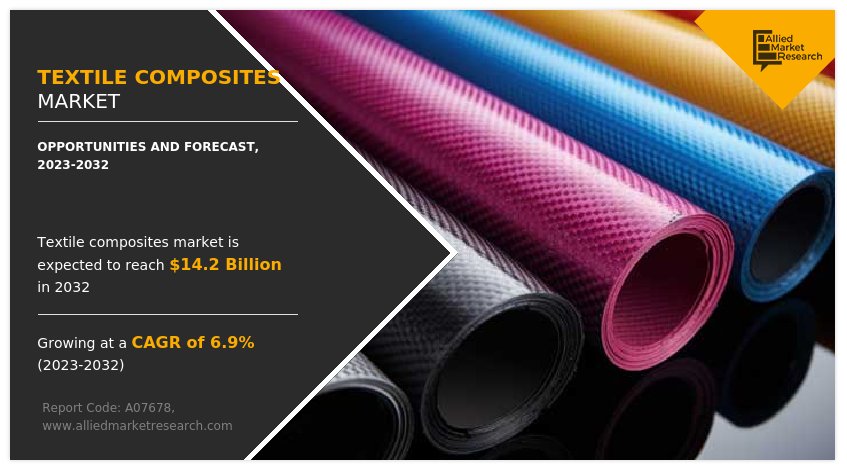
Textile composites refer to materials that combine textiles (fabrics or fibers) with other materials to create a composite material with enhanced properties. These composites are designed to take advantage of the strengths of both, the textile and the additional material, resulting in a material that exhibits improved mechanical, thermal, or other desired properties. In textile composites, the textile component usually serves as a reinforcement, providing strength and flexibility, while the additional material, which is often a polymer matrix or a resin, acts as a binding agent to hold the textile structure together. The combination of these materials results in a composite that can be tailored to meet specific performance requirements.
Applications of textile composites are diverse and can be found in various industries, including aerospace, automotive, construction, sports equipment, and protective gear. The use of textile composites can lead to lightweight and high-strength materials, making them valuable in industries where weight reduction and strength optimization are critical factors.
One of the primary drivers of the textile composites market is increase in demand for lightweight and high-strength materials across various industries. Industries such as aerospace, automotive, and sports and leisure are constantly seeking materials that offer a high strength-to-weight ratio. Textile composites, including fibers such as carbon, glass, or aramid, provide an effective solution for manufacturing complex component shapes. The lightweight nature of these composites helps reduce overall weight, contributing to fuel efficiency in transportation and improving performance in sports equipment.
Furthermore, advancements in material technologies play a crucial role in driving the textile composites market. Ongoing R&D efforts focus on enhancing the properties of textile composites, including mechanical strength, durability, and resistance to environmental factors. Innovations such as nanocomposites, which involve including nanoparticles into textile structures, have created new possibilities for improving overall performance of textile composites. These technological advancements contribute to the market growth by expanding the application areas of textile composites.
However, one of the significant restraints for the textile composites market is the cost associated with manufacturing and implementing these materials. While advancements in manufacturing technologies have contributed to cost-effectiveness, certain high-performance fibers and resins used in textile composites can still be expensive. This cost factor limits the widespread adoption of textile composites, especially in industries where budget constraints are significant, such as construction and some segments of the consumer goods market.
However, the aerospace industry presents a considerable opportunity for textile composites. As the industry evolves with the development of new aircraft models and a focus on fuel efficiency, there is a growing demand for advanced materials that can withstand aerospace conditions. Textile composites, especially those reinforced with carbon fibers, are increasingly used in aircraft components such as wings, fuselages, and interior structures. Innovations in manufacturing processes and material combinations offer opportunities for textile composites to play a crucial role in the ongoing advancements within the aerospace sector.
The global textile composites market is segmented on the basis of fiber type, textile type, application, and region. On the basis of fiber type, the market is categorized into carbon fiber, glass fiber, aramid fiber, polyethylene fiber (UHMWPE), basalt fiber, and others. By textile type, the market is classified into woven and non-woven. On the basis of application, it is divided into automotive, aerospace, construction, marine, sports equipment, industrial insulation, and others. Region-wise, the market is studied across North America, Europe, Asia-Pacific, and LAMEA.
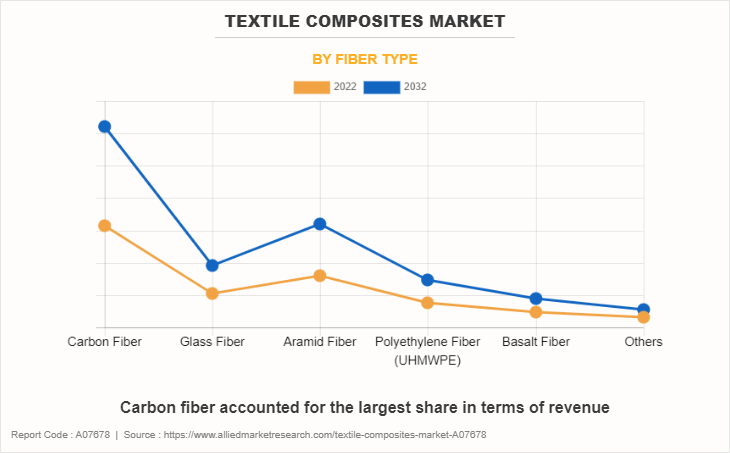
In 2022, the carbon fiber segment was the largest revenue generator, and is anticipated to grow at a CAGR of 7.0% during the forecast period. Carbon fiber is known for its exceptional strength-to-weight ratio. It is significantly lighter than traditional materials such as steel and aluminum while offering comparable or even superior strength. This makes it highly attractive in industries where weight reduction is critical, such as aerospace and automotive.
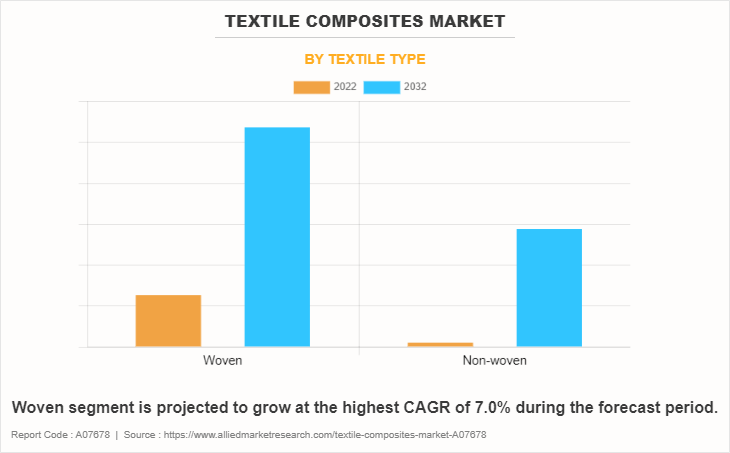
In 2022, the woven segment was the largest revenue generator, and is anticipated to grow at a CAGR of 7.0% during the forecast period. Woven textile composites combine the strength of fibers with the flexibility of weaving patterns, resulting in materials that are both strong and lightweight. This makes them ideal for applications where weight reduction without compromising structural integrity is crucial, such as in aerospace and automotive industries.
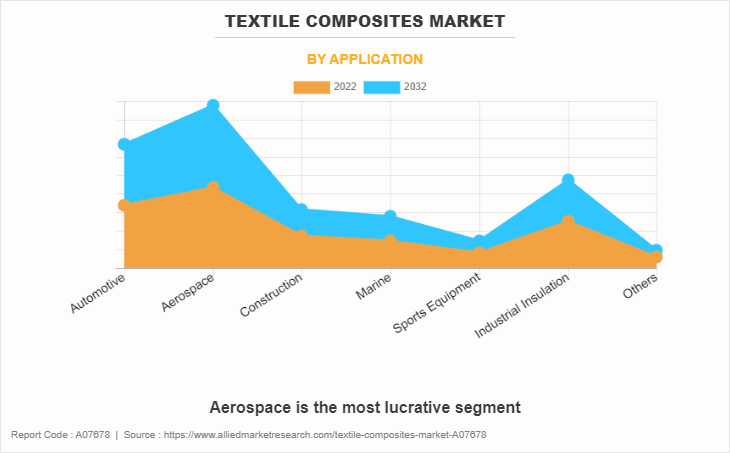
By application, the aerospace segment dominated the global market in 2022, and is anticipated to grow at a CAGR of 7.3% during the forecast period. Textile composites, particularly those reinforced with high-strength fibers like carbon or aramid, provide significant weight reduction compared to traditional metallic materials. This weight savings is crucial in aerospace applications, as it directly contributes to fuel efficiency, increased payload capacity, and overall performance.
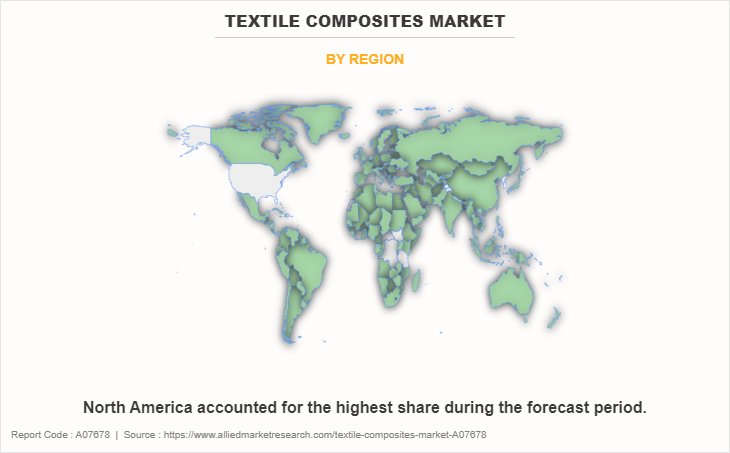
The Asia-Pacific textile composites market accounted for dominant share of textile composites market share in 2022 and is projected to grow at the highest CAGR of 7.6% during the forecast period. The Asia-Pacific region has seen a significant increase in demand for aircraft, for both commercial and defense purposes. Textile composites, with their lightweight and high-strength properties, are increasingly being used in aerospace applications, contributing to the market growth.
The global textile composites market profiles leading players such as Chomarat, SAERTEX Group, BGF Industries, Sigmatex, TORAY INDUSTRIES, INC., HYOSUNG TNC, TEIJIN LIMITED, Owens Corning, Hexcel Corporation, and Composite Fabrics of America. The global textile composites market report provides in-depth competitive analysis and profiles of these major players.
Key Benefits For Stakeholders
- This report provides a quantitative analysis of the market segments, current trends, estimations, and dynamics of the textile composites market analysis from 2022 to 2032 to identify the prevailing textile composites market opportunities.
- The market research is offered along with information related to key drivers, restraints, and opportunities.
- Porter's five forces analysis highlights the potency of buyers and suppliers to enable stakeholders make profit-oriented business decisions and strengthen their supplier-buyer network.
- In-depth analysis of the textile composites market segmentation assists to determine the prevailing market opportunities.
- Major countries in each region are mapped according to their revenue contribution to the global market.
- Market player positioning facilitates benchmarking and provides a clear understanding of the present position of the market players.
- The report includes the analysis of the regional as well as global textile composites market trends, key players, market segments, application areas, and market growth strategies.
Textile Composites Market Report Highlights
| Aspects | Details |
| Market Size By 2032 | USD 14.2 billion |
| Growth Rate | CAGR of 6.9% |
| Forecast period | 2022 - 2032 |
| Report Pages | 405 |
| By Application |
|
| By Fiber Type |
|
| By Textile Type |
|
| By Region |
|
| Key Market Players | Owens Corning, TORAY INDUSTRIES, INC., HYOSUNG TNC, Sigmatex, TEIJIN LIMITED, Hexcel Corporation, Chomarat, Composite Fabrics of America, SAERTEX Group, BGF Industries |
Analyst Review
According to the CXOs of leading companies, the textile composites market is being propelled by a combination of technological advancements, industry-specific demands for lightweight and high-strength materials, and a global shift towards sustainability. As these drivers continue to shape the landscape of various industries, the textile composites market is likely to experience further growth and diversification in the coming years.
However, while the textile composites market has witnessed substantial growth, it faces several restraints that need to be addressed for sustained development. Overcoming these challenges requires concerted efforts from industry stakeholders, including manufacturers, researchers, and regulatory bodies. The development of cost-effective manufacturing processes, increased awareness and education, advancements in recycling technologies, and collaborative industry initiatives are essential for unlocking the full potential of textile composites across various applications. Despite these restraints, the ongoing research and innovation in the field hold promise for overcoming current limitations and expanding the market for textile composites in the future.
Robust demand from automotive sector, rise in demand form aerospace sector, and increase in utilization of lightweight materials are the upcoming trends of textile composites market in the world.
Aerospace is the leading application of textile composites market.
Asia-Pacific is the regional market for textile composites
The global textile composites market was valued at $7.3 billion in 2022 and is estimated to reach $14.2 billion by 2032, exhibiting a CAGR of 6.9% from 2023 to 2032.
The global textile composites market profiles leading players that include Chomarat, SAERTEX Group, BGF Industries, Sigmatex, TORAY INDUSTRIES, INC., HYOSUNG TNC, TEIJIN LIMITED, Owens Corning, Hexcel Corporation, and Composite Fabrics of America.
Loading Table Of Content...
Loading Research Methodology...


